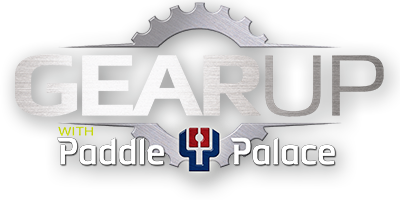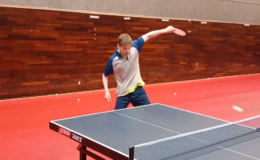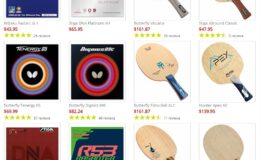 Answer by: Stellan Bengtsson, Only player to have won singles, doubles and teams at both the Worlds and Europe Championships. 67 International singles, doubles and team titles. Coached Jorgen Persson, JO Waldner, Peter Karlsson and Erik Lindh, all World and Europe Champions.
Answer by: Stellan Bengtsson, Only player to have won singles, doubles and teams at both the Worlds and Europe Championships. 67 International singles, doubles and team titles. Coached Jorgen Persson, JO Waldner, Peter Karlsson and Erik Lindh, all World and Europe Champions.
The advantages of the carbon blade are a bigger sweet spot and a faster ball. These days the carbon blades have pretty good feeling as well so there are really no disadvantages. The wood blades have a great feeling but many of them are slower. With the 40mm ball I recommend carbon.
Answer by: Massimo Constantini, ICC Head Coach, ITTF High Performance Coach.
The choice of equipment depends exclusively on the player’s style and features.
First of all it is important to know how a blade is made. The table tennis manufacturers combine wood and carbon in multiple layers, so to my knowledge there are no pure carbon blades. However, there are a lot of all wood blades. The combinations may vary like 3 layers of wood and 2 of carbon, or 5 layers of wood and 2 of carbon, or in some cases 2 wood layers and 3 carbon layers, and so on.
What we call a multilayer blade is a combination of various woods and carbon. When you add a layer of carbon you have the following advantages: precision, uniformity of bounce, stability and good quality of speed. In some cases you gain a good quality of control (block and push), but the spin is reduced because the blade has a sort of stiffness. The disadvantages, as I just said, are the reduced quantity of spin. But once again it depends on the combination (layers of carbon and wood).
On the other side, blades made only of wood can be inconsistent initially but, as per the characteristics of wood, over time they change, permitting an ideal feeling for the player who regularly plays with it. We say: “A wood blade is alive.” Time affects wood’s characteristics but at the same time players naturally adjust and adapt to obtain perfect habits. Usually the best bounce from a wood blade is at the centre with some weaknesses at the edges. Carbon blades can help solve this problem.
However from my point of view this is irrelevant because at the end of the day, what makes the difference is the feeling a player achieves and the confidence they can gain from choosing a blade that fits their own purpose.
Answer by: Jasna Rather, Head Coach Texas Wesleyan University
It really depends on which carbon blade or wood blade we talk about as there are differences between all carbon blades and wood blade groups.
Most carbon blades are very fast, but you can feel vibrations and you have less control. There are few carbon blades that have thicker layers which mean that there is less or no vibration at all, but they could be extremely fast. It also depends if the blade is hard, medium or soft on how much control a player can have.
Wood blades if made from good quality wood could be great because they have better control and overall feeling. It is true that now days it is more difficult to play with a blade that has no carbon or some fiber layers because there is no more re-gluing. In that sense, carbon blades have that advantage right now.
Every player has different needs and what works for one might not work for another because of style difference. All carbon and wood blades have their own advantages and disadvantages, it is on players to figure out what best works for them and to adjust the best possible to a new racket.
There are so many new blades on the market and they need to test them. They will be amazed how much a blade can change the game.
Answer by: Tahl Leibovitz, USATT National Coach and Paralympic Gold Medalist
When you are using a wood blade you will have more control and more feeling with the ball. It is easier to block with the wood blade and overall you have more control. Carbon blades tend to be faster. You will have more speed on your attacks but, less control. The best thing to do is to try and find a blade that is fast but, at the same time still has good control. In my opinion the Stiga Clipper Classic has great control and very good speed.
Answer by: Sara Fu, Texas Wesleyan University Team, 2011 NCTTA Women’s Singles Champion and Mixed Doubles Champion, Rated 2437.
The advantages of carbon blades are that they are very powerful and fast. They are really good for attacking by high level players. The disadvantages of carbon blades are that they are very hard to control especially on short ball games. The advantages of wood blades are very easy to control, but it is not good for long distance loopers.
Answer by: Samson Dubina, Rated 2461, 2009 US Men’s National Finalist.
Generally, carbon blades are faster and more suitable for the advanced player. For a beginner, it is best to choose a very slow, controlled wood blade. This will allow the player to develop solid strokes because the ball has more dwell-time on the racket. A faster blade is better for an attacking player who contacts the ball at the top of the bounce. A controlled blade is better for a defensive or all-around player who plays from many different distances from the table.
Wood blades have more feel and vibration than carbon blades. As a beginner, it is important to “feel” the ball. For this reason, I would suggest using an all-wood blade for the first three years. After a player has excellent strokes and feeling, it would be advisable to possibly move up to a carbon blade for added power. At the elite level, players who mainly use power to win points generally play with carbon blades for a hard feel. Elite players who use touch to win points generally play with all-wood blades for a much softer feel.
Carbon blades have a larger sweet-spot due to the reinforced layers and harder feeling of the blade. This will give slightly more room for error if the player doesn’t contact the ball in the center of the racket.
The final factor to consider is the cost. Most wood blades cost between $40-$100. Most carbon blades cost between $60-$200. If a player uses the racket for at least 1 year, paying the extra money is possibly worth it. The racket will last for 5-10 years.
In the first 3 years of playing, I would encourage the beginner to select the 5-ply, all wood Nittaku Rising blade. For those players wanting to use a fast carbon blade, I would suggest using the Nittaku Survellian. For those players wanting a fast wood blade, I would suggest the Nittaku Ludeak (which I personally use).
A. Carbon blades are generally faster (but not always)
B. Carbon blades have less vibration and a harder feel
C. Carbon blades have a larger sweet-spot
D. Carbon blades cost more
Answer by: Scott Lurty, Rating 2328, SPIN New York Coach
An all wood blade will provide a better ball feeling, tend to have more flex when looping and allow for easier time imparting spin on the ball at lower racket speeds. On the other hand, most Carbon blades provide a larger sweet spot, a more rigid feel and are generally better suited to softer rubbers to balance the stiffness unless you are a very high level player who can control a carbon blade with hard fast rubber.



